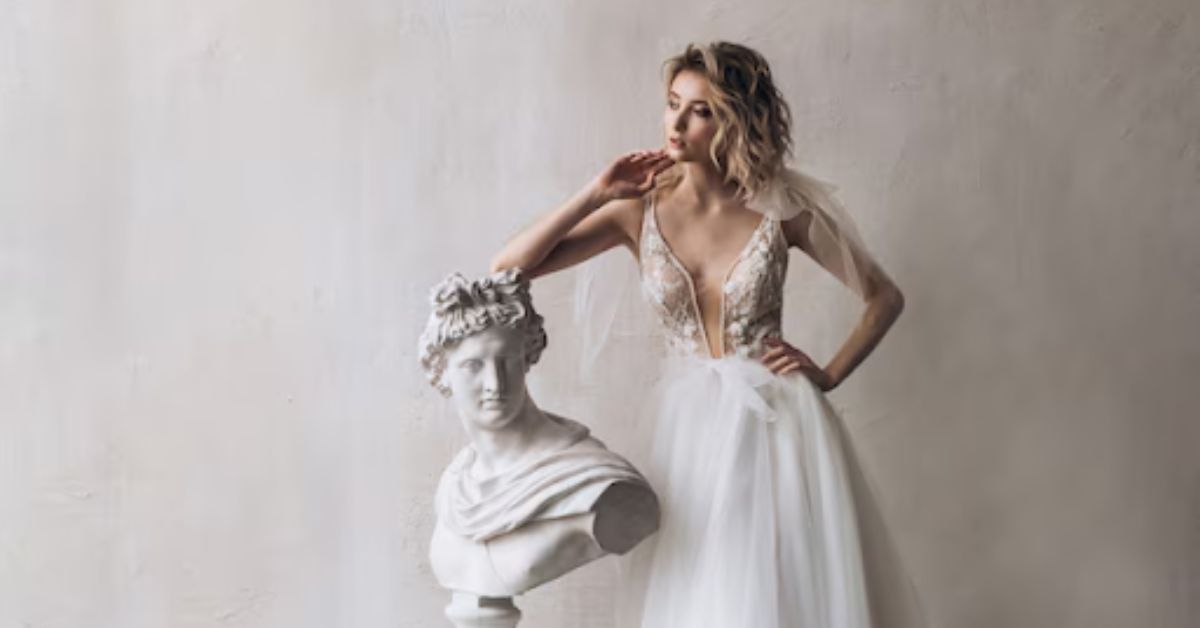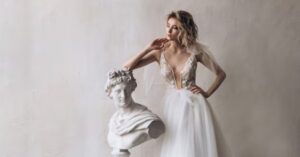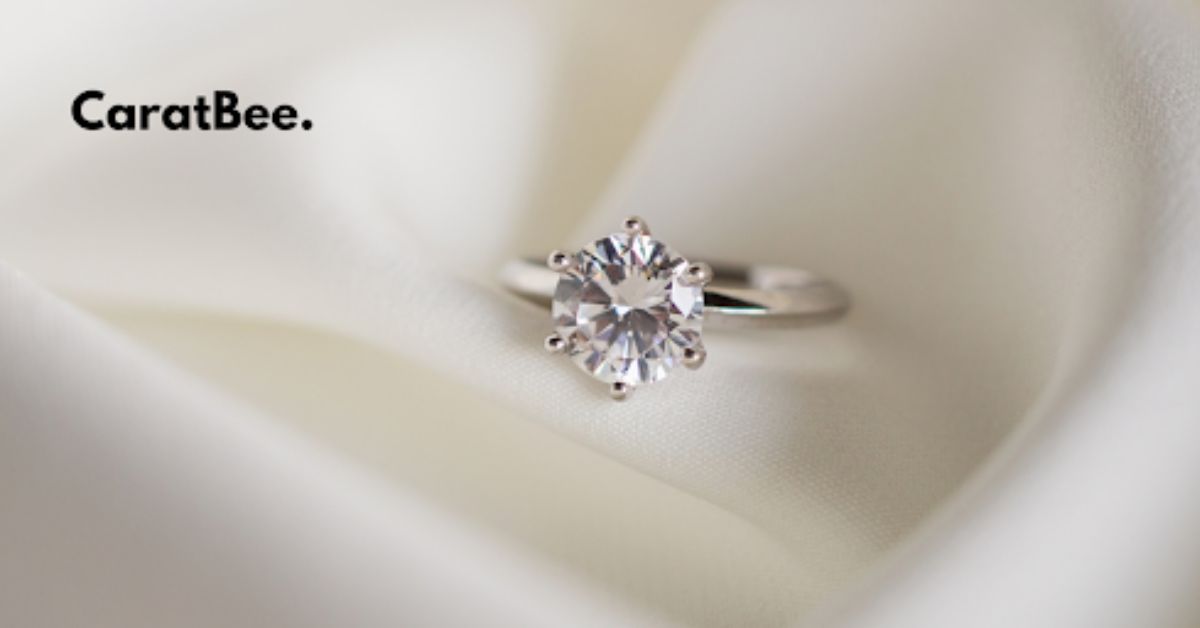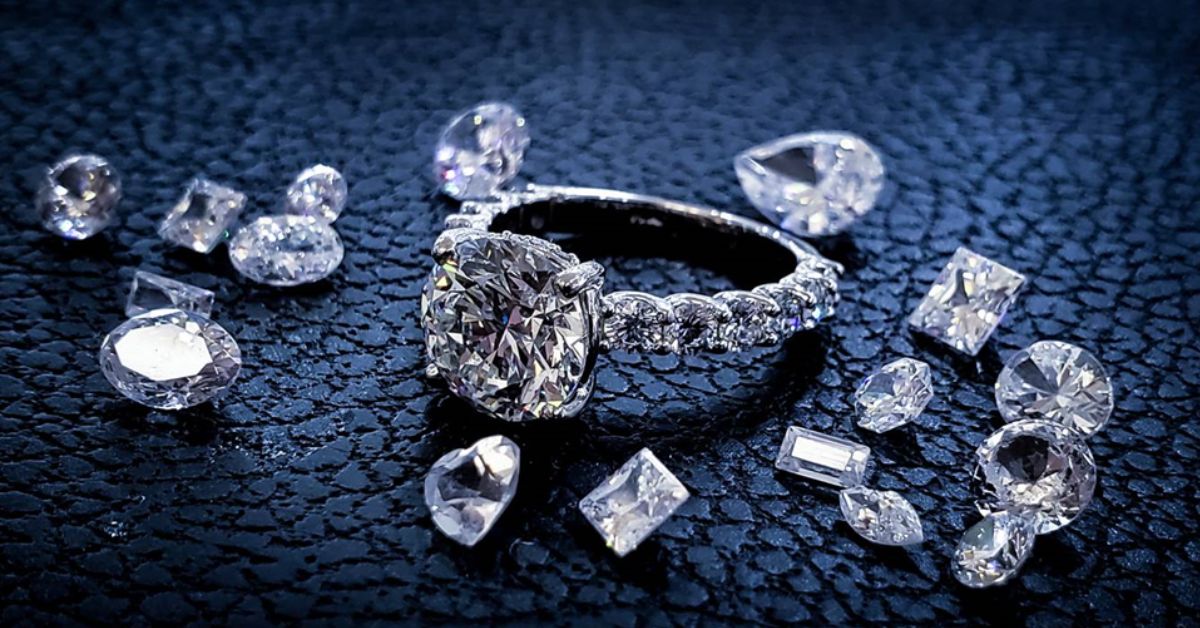FASHION
Types of Necklines You Can Consider For Wedding Dress

Finally, your special day is around the corner. The excitement and planning are at their peak, and it feels like a rollercoaster ride, right? But in all this, there is the hunt to find the perfect wedding dress. The dress will become a witness to your “I do” moment and a memory to cherish forever.
However, selecting a dress is not as simple as you think because you must consider many factors, from fabric to budget. The neckline is also important because it helps you enhance your look, flatter your figure, and highlight your features.
Additionally, there are different types of necklines available that you might not be aware of. But now you don’t have to worry because here we’ll tell you about different types of necklines that you can consider for a wedding dress.
Types of Neckline:

Strapless Neckline:
This neckline sits just above the bust, bare of arms and shoulders. A Strapless neckline symbolizes timeless and elegant style, perfect for brides who want to flaunt their shoulders and collarbones.
Off-Shoulder Neckline:
Off-shoulder necklines drape below the shoulder, showing the collarbones and shoulders while creating an ethereal look. This style is perfect for brides who want a combination of charm and contemporary elegance. It goes with fitted and flowing gowns, adding a touch of femininity and grace to your overall look.
Sweetheart Neckline:
The Neckline is shaped like the top half of the heart, accentuating the lower neck and adding a romantic touch. It compliments all body types, especially for brides who want to enhance their bust. This classic neckline pairs well with different gown styles, from ball gowns to mermaid dresses.
V-Neckline:
A V-neckline helps elongate the neck and torso, creating a slimming effect. It is a versatile choice that goes with both modest and daring brides. V-necklines are perfect for those who want to add sophistication and allure to their wedding dresses.
Asymmetric Neckline:
The neckline features a single shoulder strap, creating a modern, off-balance, unique style. It can be the best choice for brides and bridesmaids’ dresses who want to make a bold fashion statement. This neckline draws attention to the shoulder and collarbone, working well with sleek, minimalist gowns.
Halter-Neckline:
A neckline that wraps around the neck, leaving the shoulders and back exposed. This cool and contemporary style is great for highlighting toned arms and shoulders. The style is designed for modern brides who prefer a sleek and athletic look.
Queen Anne Neckline:
The neckline features a high collar at the back with a sweetheart shape in front. The style signifies the regal and sophisticated vintage charm with elegance, perfect for brides seeking a timeless look.
Perfect Innerwear and Accessories to Wear With Different Necklines
Queen Anne Neckline:
Innerwear: A supportive strapless or convertible bra will be the best choice for a Queen Anne neckline, which features a high collar in the back and a V-neck in the front.
Accessories: You can pair your wedding dress with delicate drop earrings or a necklace that fits within the open neckline.
Strapless Neckline:
Innerwear: You can choose a well-fitted strapless bra, which is essential to provide support and prevent malfunction.
Accessories: Go for a choker to draw attention; pair it with bold earrings if you choose to forgo a necklace. You can choose a simple bracelet to add a simple touch of elegance.
Off-Shoulder Neckline:
Innerwear: Adhesive cups are perfect for an off-shoulder neckline, ensuring support without visible straps.
Accessories: To complement this romantic style, you can opt for a choker or short pendant. Earrings such as chandeliers or drop earrings can add a touch of glamor. A bracelet will make you look complete.
Sweetheart Neckline:
Innerwear: To enhance the shape of your sweetheart neckline while wearing this style, you can choose a corset or strapless bra.
Accessories: Opt for a necklace that shows the curve of the neckline, such as a sweetheart necklace or short pendant. Additionally, you can wear simple earrings and a matching bracelet to complete the look.
V-Neckline:
Innerwear: A plunge bra is ideal for a V-neckline, providing support while remaining invisible under the deep cut.
Accessories: To enhance the elongating effect, choose a pendant necklace that follows the V shape of the neckline. For earrings, opt for a subtle and delicate bracelet to keep the focus on the neckline.
Asymmetric Neckline:
Innerwear: A convertible bra with a one-sided detachable strap will be the best option for needed support while remaining hidden.
Accessories: opt for the bold earring on the exposed shoulder and stud on the other, as the neckline is already a statement. Choose a sleek bracelet to add a modern touch without overshadowing necklines.
Halter-Neckline:
Innerwear: A halter-style bra that can be adjusted to fit the neckline will be the perfect option.
Accessories: Frogo a necklace to keep the neckline clean; instead, choose a statement earring, like a chandelier or drop style, to gain attention on your face.
Extra Tip: Selecting the right innerwear and accessories for your dress neckline is as important as choosing makeup and shoes.
Conclusion:
Choosing the perfect neckline for your wedding dress enhances your look and highlights your best features. From timeless strapless to elegant off-shoulder, romantic sweetheart, and modern asymmetric styles, each neckline offers a unique charm. Pairing the right innerwear and accessories ensures a flawless appearance, making your special day even more memorable and beautiful.
FASHION
A Closer Look at 3 Carat and 7 Carat Diamond Rings

When it comes to buying an engagement ring, one of the most exciting & daunting, decisions is choosing the perfect diamond. You’ve probably come across terms like “carat,” “cut,” “clarity,” and “color” in your search, but carat weight often takes center stage, as it directly affects how noticeable your diamond will be. If you’re considering a 3 carat diamond ring or a 7 Carat Diamond Ring, we’re here to guide you through everything you need to know!
This blog will cover what carat weight means, the size differences between 3 carat and 7 carat diamonds, and how to choose the right one for you. We’ll also explore popular ring settings and what to keep in mind before making your purchase.
Whether you’re finalizing a proposal ring or simply exploring options, you’re in the right place.
What is a Carat?
Carat is a unit of weight used to measure diamonds and other gemstones. One carat equals 200 milligrams or 0.2 grams. While it doesn’t directly measure the size of a diamond, carat weight heavily influences a diamond’s perceived size.
For example, some cuts, like emerald or marquise, appear larger due to their shape, even if they weigh the same as a round brilliant cut. It’s important to remember that carat is just one factor of many that contribute to your diamond’s brilliance and overall appearance.
Now, let’s get into the specifics of 3 carat and 7 carat diamonds.
How Large is a 3 Carat Diamond?
While carat weight relates to the diamond’s weight, its dimensions can differ depending on the cut. On average, a 3 carat diamond with a round brilliant cut is approximately 9.3 millimeters in diameter. To give you some perspective, that’s about the size of the eraser on a standard pencil.
However, the diamond’s shape can make it appear slightly larger or smaller, depending on how the weight is distributed in the cut. Oval, pear, or marquise shapes tend to look larger compared to round diamonds of the same carat weight thanks to their elongated silhouettes.
Overview of 3 Carat Diamond Rings
A 3 Carat Diamond Ring is a showstopper. This weight strikes a balance between size and wearability, making it a popular option for those who want their ring to make a statement but still feel comfortable wearing it daily.
Why Choose a 3 Carat Diamond Ring?
- Bold yet practical for everyday wear.
- A wider variety of settings and designs to choose from.
- More budget-friendly compared to larger carats.
Popular settings for a 3 carat diamond ring often include solitaire, halo, and three-stone designs, each enhancing the diamond’s brilliance in unique ways.
Just How Big is a 7 Carat Diamond?
Now, if you thought a 3 carat diamond was impressive, a 7 carat diamond is in another league entirely! A round brilliant 7 carat diamond typically has a diameter of about 12.2 millimeters. That’s roughly the size of a cherry or a dime!
A ring of this caliber is instantly eye-catching and demands attention wherever you go. It’s the epitome of luxury and ideal for those who want a truly dazzling piece.
Overview of 7 Carat Diamond Rings
A 7 carat diamond ring isn’t just a piece of jewelry, it’s a statement. With a diamond this size, you’ll find that the setting itself also plays a larger role in the overall design to give it proper support and security.
Why Choose a 7 Carat Diamond Ring?
- Unparalleled wow factor and glamour.
- Perfect for special occasions or collectors of fine jewelry.
- Represents luxury and exclusivity.
Settings for 7 carat diamond rings are often more elaborate, such as double halos or intricate vintage-inspired designs, ensuring the diamond remains stable and secure.
Choosing Between 3 Carat Diamond Rings Vs 7 Carat Diamond Rings
Not sure which size is right for you? Here are a few things to consider when deciding between a 3 carat diamond ring and a 7 carat diamond ring.
Lifestyle:
If you plan to wear your ring daily, a 3 carat diamond ring might be more practical. A 7 carat diamond, on the other hand, may feel heavier and is better suited to those who prefer a statement piece for special occasions.
Budget:
There’s no denying it, carat weight is one of the biggest determinants of a diamond’s price. A 7 carat diamond is exponentially more expensive than a 3 carat one, so assessing your budget is important before falling in love with the sparkle.
- Approximately Price Range is 3 carat diamond ring:
- Lab Grown Diamond – VVS2 : $2,600 – $3,200
- Moissanite Diamond – VVS1: $1,100 – $1,600
- Approximately Price Range is 7 carat diamond ring:
- Lab Grown Diamond – VVS2 : $5,500 – $8,000
- Moissanite Diamond – VVS1: $3,500 – $5,500
Personal Style:
Do you love subtle elegance or over-the-top glam? A 3 carat diamond is ideal for timeless classic looks, while the 7 carat variety is for those who want all eyes on them.
What Are the Best Settings for 3 Carat and 7 Carat Rings?
To showcase your diamond’s beauty, choosing the right setting is crucial.
Ideal Settings for 3 Carat Diamonds
- Solitaire: Keep it classic with a single, stunning diamond. A solitaire setting allows the diamond to shine without distractions.
- Halo: Surrounding a 3 carat diamond with a ring of smaller diamonds enhances its perceived size and brilliance.
- Three Stone: Two smaller diamonds on either side complement the central 3 carat diamond beautifully.
Ideal Settings for 7 Carat Diamonds
- Double Halo: Two layers of smaller diamonds amplify the already captivating sparkle of a 7 carat diamond.
- Vintage-Inspired: Intricate designs add to the timeless and luxurious appeal of such a large diamond.
- Security-Focused: Ensure the setting provides strong prongs or a bezel to keep your diamond safe and secure.
Things to Consider When Buying
Before making your purchase, here are a few practical tips to keep in mind.
- Certifications Matter: Ensure your diamond includes a grading report from a reputable organization like the GIA to guarantee its quality.
- Consider Cut, Clarity, and Color: These three factors play a significant role in the diamond’s overall beauty. Don’t prioritize carat weight at the expense of these other crucial elements.
- Shop Around: Explore dealers who specialize in high-quality or custom diamond rings, like CaratBee, to ensure you’re getting the best value.
Conclusion
Choosing between a 3 carat diamond ring or 7 carat diamond ring depends entirely on your lifestyle, preferences, and budget. Both options offer unparalleled beauty and bring unique benefits, whether the practicality and elegance of a 3 carat diamond or the jaw-dropping glamour of a 7 carat stone.
Whichever you select, focus on quality and craftsmanship to make your investment shine for years to come.
Looking for the perfect diamond ring? Browse CaratBee’s range of exquisite diamonds and find your dream piece today.
FASHION
Best Place to Buy Diamonds Online – A Complete Guide

In today’s digital world, buying a diamond online is easier than ever. Thanks to the convenience of shopping from your couch, you can browse through a huge selection of diamonds with just a few clicks. Among the many options out there, Shop at Rare Carat to experience the top choice for purchasing diamonds. As America’s go-to source for unbiased advice on diamond engagement rings, Rare Carat provides an outstanding experience for anyone on the hunt for high-quality diamonds at great prices.
So, what exactly is Rare Carat?
Rare Carat, LLC is a one-of-a-kind online platform that offers a full range of services for diamond buyers. Focusing on engagement rings and diamonds, it provides a smart way to compare over a million natural and lab-grown diamonds. The company partners with trusted retailers and gives clear insights into diamond quality, helping customers make well-informed choices. If you’re in the market for a diamond, Rare Carat makes sure you’re getting the best deal possible, whether it’s a dazzling round diamond for an engagement ring or a beautiful piece of jewelry for a special occasion.
One of the standout features of Rare Carat is its ability to compare diamonds from various retailers, making the shopping experience much smoother. This comparison tool helps customers find the best prices and discover diamonds that fit their unique preferences. Plus, Rare Carat’s gemologist checks on GIA-certified diamonds add an extra layer of reassurance, ensuring that every diamond meets the highest standards of quality.
The Perks of Shopping with Rare Carat
Competitive Pricing
When it comes to buying diamonds, one of the biggest worries for most shoppers is getting the best bang for their buck. Rare Carat tackles this issue head-on by offering competitive pricing. The platform’s ability to compare diamonds from a range of trusted retailers means customers can snag the best deals without sacrificing quality. Whether you’re after a natural diamond or a lab-grown one, Rare Carat’s comparison tool helps buyers find exactly what they’re looking for.
Exceptional Diamonds
Having high quality standards is at the core of what Rare Carat offers and it strives to guarantee that all diamonds being sold are of the best quality. The site only collaborates with well-known sellers who have GIA accredited diamonds. GIA is a leading authority in the diamond industry and their certification guarantees that the diamonds have met the cut, color, clarity, and carat weight criteria including other factors. This makes GIA diamonds some of the best in the market which many buyers look for.
Rare Carat sells diamonds that are ethically made in labs as well. These diamonds offer a much more environmental friendly and responsible option in comparison to buying natural diamonds. The process of these diamonds creation includes reproducing the natural processes within a controlled environment enabling for the lowest impact on nature, all while sustaining the qualities of a mined diamond.
Outstanding Client Care
Not only does Rare Carat maintain high standards of quality in their diamonds, but they also excel in customer service. The company has a variety of tools to assist purchasers with the often challenging task of buying a diamond. One of the highlights is the 4 Cs Diamond Buying Guide, which offers information on the most important characteristics of diamonds: cut, color, clarity, and carat weight along with other features. This guide explains to customers what high quality diamonds are and how to choose the perfect one for their needs.
Moreover, Rare Carat offers free gemologist checks on all GIA-certified diamonds. This service is invaluable for customers who want an expert opinion on the diamonds they are considering. Having a gemologist assess a diamond ensures that buyers are getting exactly what they pay for, providing peace of mind during the purchase process.
Patterns in the Diamond Market
While the diamond industry is constantly changing, there are some trends that affect how consumers purchase diamonds. Most prominent among them is the rapid acceptance of lab-grown diamonds. These diamonds have gained popularity for their ethical concern as well as their lower prices. The company Rare Carat is a leader in these types of diamonds and sells lab-grown diamonds to eco-friendly buyers.
Another trend is the increasing popularity of customized engagement diamond rings. Consumers want to purchase products with distinct designs that suit their individuality, and this is what custom made diamonds from Rare Carat are intended to do. From elaborate designs to classic solitaires, Rare Carat offers all shoppers the ability to customize their diamonds to their preferences.
Challenges and Opportunities
The diamond business on the internet has plenty of prospects, but it also has some problems. One of the major issues is the intricacy involved in choosing a diamond. Buyers may get overwhelmed with the myriad choices available and may lack the know-how concerning the details of diamond quality. But Rare Carat makes the selection easier by providing expert help in conjunction with tools such as a 4 Cs Diamond Buying Guides and gemologist checks, facilitating an easier diamond buying experience for everyone.
Conclusion
When it comes to buying diamonds online, Rare Carat truly shines as the top choice. They offer a fantastic mix of competitive prices, stunning diamonds, and outstanding customer service. With their commitment to transparency, expert guidance, and user-friendly tools, it’s no wonder they’re the go-to for anyone on the hunt for a diamond. Whether you’re after a natural gem or a lab-grown option, Rare Carat helps you make an informed choice while snagging the best deal. Their dedication to customer satisfaction and innovation really sets them apart, making Rare Carat the ultimate destination for diamond enthusiasts.
FASHION
What Do People Wear To SXSW?

If there’s one place where fashion, music, tech, and film collide in a perfect storm of cool, it’s SXSW. Every March, thousands of creatives, industry pros, and music lovers descend upon Austin, Texas, for a week of panels, showcases, and epic street style.
Unlike the hyper-curated aesthetics of Coachella or the grunge-meets-glam of Lollapalooza, SXSW fashion thrives in that sweet spot between effortlessly stylish and comfortable.
What do people wear to SXSW? The short answer: whatever makes them feel like the coolest version of themselves. The long answer? A carefully crafted blend of vintage, streetwear, and practical staples designed to handle long days, unpredictable Texas weather, and spontaneous adventures.
What Is SXSW’s Aesthetic?
If SXSW had an official dress code, it would read: “Look like you didn’t try too hard, but still turn heads.” It’s a festival where authenticity is the name of the game, and that extends to fashion.
There’s also an element of practicality. SXSW isn’t a festival where you’re parked in one spot all day — you’re bouncing between venues, chasing secret shows, and walking a lot. This means your outfit has to strike the perfect balance between stylish and functional.
More than anything, SXSW fashion is about self-expression. It’s a chance to showcase your personality, whether that’s through a perfectly broken-in leather jacket, a pair of funky sunglasses, or a signature accessory that makes your outfit pop.
What Are Must-Have SXSW Staples?
Dressing for SXSW is all about finding that perfect mix of style and function, and a few key pieces dominate the scene year after year.
One of the biggest staples you’ll see at SXSW is vintage graphic tees. Whether it’s an old-school band shirt, a faded ‘90s movie print, or a thrifted relic from a forgotten tourist attraction, a well-worn tee is a go-to for festival-goers. It’s the kind of piece that looks effortlessly cool, feels incredibly comfortable, and pairs with just about anything — denim cutoffs, high-waisted jeans, or layered under a leather jacket.
Speaking of festival must-haves, denim is everywhere. From distressed shorts to vintage Levi’s to oversized trucker jackets, SXSW fashion thrives on its ability to make casual look intentional. The more lived-in, the better.
Shoes are another integral part of SXSW style, and comfort is non-negotiable. With so much walking involved, flimsy sandals just won’t cut it. Sneakers dominate the scene, particularly classic white kicks or retro high-tops, but boots are just as popular, especially for those looking to add a little edge to their look.
Finally, layering is key for dealing with Texas’ unpredictable spring weather. Early mornings can be chilly, afternoons get hot fast, and nights often bring a cool breeze, so having a lightweight jacket, an oversized button-up, or a cropped hoodie on hand is essential. These pieces help create that effortless, layered look that defines SXSW style.
How Can You Stand Out?
While SXSW fashion is rooted in casual cool, it’s also the perfect place to make a statement. Accessories and bold styling choices help festival-goers stand out in a sea of denim and sneakers, proving that even a laid-back outfit can have a little extra edge.
Funky sunglasses are everywhere — think oversized ‘70s frames, retro aviators, or colorful tinted lenses that make the simplest outfit feel intentional. Hats are another favorite, from classic wide-brim fedoras to vintage trucker caps that add just the right amount of indie-rock energy.
Sustainability is also a huge part of SXSW style, with more people opting for thrifted, upcycled, and small-batch indie designer pieces. This means outfits often feature one-of-a-kind items, whether it’s a reworked band tee, a hand-painted leather jacket, or patchwork denim.
SXSW is the type of place where a mix of high and low fashion thrives, like designer sneakers paired with a vintage tee or an expensive bag worn with thrift-store jeans. The beauty of SXSW style is that it doesn’t feel overly curated or forced. Instead, it’s all about looking effortlessly unique, as if you just happened to throw on the coolest pieces in your wardrobe before heading out the door.
The Key to SXSW Style
The best SXSW outfits aren’t about following trends — they’re about embracing individuality. The festival’s unique mix of music, film, and tech creates an environment where personal style is celebrated, and there’s no single way to dress for it. Comfort is key, but creativity rules and the best looks strike a balance between effortless and expressive.
Layer smart, choose shoes that can handle a full day of walking, and throw in a few statement pieces that feel true to you. From a vintage tee to a bold accessory to a killer jacket, SXSW fashion is all about making it your own. Have fun!

 Cartoon1 year ago
Cartoon1 year agoUnlocking the Potential of Nekopoi.care: A Comprehensive Guide

 Game1 year ago
Game1 year agoExploring Aopickleballthietke.com: Your Ultimate Pickleball Destination

 BUSINESS1 year ago
BUSINESS1 year agoWhat Companies Are In The Consumer Services Field

 BUSINESS12 months ago
BUSINESS12 months agoUnraveling the Mystery of 405 Howard Street San Francisco charge on Credit Card

 HOME IMPROVEMENT1 year ago
HOME IMPROVEMENT1 year agoVtrahe vs. Other Platforms: Which One Reigns Supreme?

 TECHNOLOGY12 months ago
TECHNOLOGY12 months agoThe Guide to Using Anon Vault for Secure Data Storage

 ENTERTAINMENT8 months ago
ENTERTAINMENT8 months agoUnderstanding Bunkr Album: A Comprehensive Guide

 ENTERTAINMENT1 year ago
ENTERTAINMENT1 year agoThe Epic Return: Revenge of the Iron-Blooded Sword Hound
















